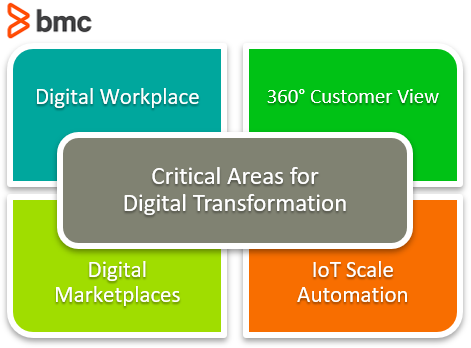Throw a rock and you’ll hit an organization undergoing their “digital transformation” nine times out of 10 these days. This is true for good reason. The entire world has been undergoing its own digital transformation over the past few decades as technology has advanced in leaps and bounds. Embracing the digital world is all but mandatory for organizations of all shapes and sizes.
In 2025, digital transformation is more than just a buzzword — it’s a strategic imperative. It means staying competitive and evolving to better serve customers. That’s why worldwide digital transformation spending is expected to top $3.9 trillion by 2027, growing at a rate of 15.1% a year. Recent research from Deloitte found:
- 51% of companies are making fundamental changes by integrating digital technologies.
- 32% assign a high to medium value to their digital initiatives.
- 75% report a return on investment and contribution to operating margin.
Achieving the speed and agility necessary for competing in today’s business environment requires that organizations undergo a digital transformation. Yet though change is seen as vital, companies are struggling to execute:
- Just 39% of organizations believe they capture enough data to understand customers.
- 30% use insights to improve products.
- 47% of C-suite executives think less than half of workers embrace digital transformation.
- Only 21% of organizations hold their C-suite accountable for digital transformation.
Here’s what digital transformation entails and how your organization can more effectively work toward it.
What is digital transformation?
Digital transformation can be defined as:
“The use of new, fast and frequently changing digital technology to solve problems.”
This idea of digital transformation is apt in terms of what it is—but it fails to provide any real guidance on how to achieve digital transformation.
Digital transformation does involve the application of new technology. But bringing all your operations onto the cloud won’t magically empower your organization with some sort of digital wizard powers. While moving to the cloud or adopting other new technologies may be a great idea for your organization, you won’t reap the rewards of a digital transformation without enacting actual change within your organization.

The most important aspect of digital transformation isn’t really the technology itself, but the transformation of culture and practices of the organization itself. Undergoing digital transformation requires your organization to change its approach to virtually everything you do. Truly embracing digital transformation requires that organizations and their members challenge the status quo and learn to experiment and implement changes frequently. Experimentation and willingness to fail are essential for adopting the digital mindset.
The reality is that digital transformation looks different for every organization, and this reality makes describing the steps necessary for a digital transformation tricky at best. But digital transformations can be better defined by talking in terms of what the end goal of a digital transformation is: the creation of a digital platform.
What is a digital platform?
In business enterprise terms, a digital platform can be thought of as the sum total of a place for exchanges of information, goods, or services to occur between producers and consumers as well as the community that interacts with said platform. It’s imperative to understand that the community itself is an essential piece of the digital platform—without that community, the digital platform has very little inherent value.
We interact with digital platforms on a constant basis thanks to the success of the digital platform approach. Digital platforms take a lot of different forms depending on the business model they employ and the specific purposes they seek to serve. Examples of successful digital platforms are:
- Social media platforms like Facebook, Twitter, Instagram, and LinkedIn
- Knowledge platforms like StackOverflow, Quora, and Yahoo! Answers
- Media sharing platforms like YouTube, Spotify, and Vimeo
- Service-oriented platforms like Uber, Airbnb, and GrubHub
As you can see, digital platforms are by no means a new approach nor are they narrowly used in terms of their particular use cases. Digital platforms provide value to everyone within the ecosystem of the platform while turning a profit for the organization that created and maintains it through various business models, such as:
- Advertising
- Subscriptions
- Pay as you go
- Any combination of these and other profit-turning methods
Characteristics of digital platforms
Another way to describe digital platforms is by talking about the essential pieces necessary to create a successful digital platform. The key aspects of a digital platform are:
- Ease of use and immediate appeal for users
- Trustworthiness and security (clear terms and conditions are necessary as well as privacy protection and assurances for intellectual property and data ownership)
- Connectivity through the use of APIs that allow 3rd parties to extend the ecosystem of the platform and its capabilities
- Facilitation of exchanges between users (producers and consumers)
- Providing value to the community and as a function of the size of the community (the bigger the community, the more value the platform can provide to all parties involved)
- Ability to scale without causing performance degradation
Digital transformations look different for each company because every organization has different goals in mind, but a tangible goal to seek through digital transformation is the creation of a digital platform. While there is no shortage of digital platforms, there is still plenty of room for innovation and niche services that have audiences waiting for the day when their needs are finally met.
Digital platform examples
Digital platforms that support more efficient business functions and facilitate data capture and usage come in all shapes and sizes, covering essential functions across an enterprise. Some prominent examples of digital platforms include:
- E-commerce: These platforms enable you to buy and sell online. Amazon, Shopify, and Alibaba are examples.
- Content creation: These platforms, like YouTube, Canva, and Adobe Creative Cloud, make it easy to create professional-looking multimedia content.
- Business collaboration: Being able to work together remotely, streamline communications, and manage projects is easy through Microsoft Teams, Slack, Zoom, and Asana.
- Knowledge sharing: People can streamline information sharing on Quora, Reddit, and other user-generated content publishing platforms.
- Learning: Training staff and supporting professional development is expedited through Coursera, LinkedIn Learning, Udemy, and other industry-specific platforms.
- Social media: Networking, marketing, and building communities have been transformed by Facebook, Instagram, LinkedIn, and others.
- Gaming: Bringing players together to collaborate in pursuing a shared goal is facilitated by Steam, Xbox Live, Playstation Network, and Twitch.
- Financial services: Your business can handle all aspects of digital payment processing on platforms like PayPal, Square, Stripe, and Robinhood.
- Transportation and travel: Apps like Uber, Lyft, Airbnb, and Booking.com make it simple to get from point A to point B and track details along the way.
- Healthcare: Telehealth and health management platforms like Teladoc, MyChart, and Zocdoc bring wellness online and make it more accessible.
Creating a digital platform
Many digital platforms compete for similar audiences but leverage their competitive advantages and unique aspects to reach their particular audience as they seek to grow. Certainly some digital platforms like Facebook and YouTube have a chokehold on the largest portions of market share. But these are by no means fixed on their seats of power as new competitors vie for domination.
Importantly, unseating the giants at the table isn’t a necessary step for finding your own success.
Creating a digital platform for your organization will provide you with a competitive advantage over your rivals by ensuring you service your niche with the massive value proposition of not only the services, but also your platform’s community. A successful digital platform performs two key functions:
- Facilitates exchanges of goods, services, or information
- Leverages the community to provide enhanced value to everyone within the ecosystem
Embracing digital transformation by empowering your organization to challenge the status quo and experiment without fear of failure is essential for innovation that will allow you to carve out your own niche. Creating a powerful digital platform that provides ease of use, trustworthy transactions, and protections for users from bad actors on the platform is a delicate balancing act that has the ability to provide incredible levels of success for those who can manage it.
Benefits of a digital platform
Using existing digital platforms is a fast track to modernizing your operations for a relatively painless and affordable digital transformation. Integrating these technologies is easier than creating them from scratch and offers a number of benefits, including:
- Improved customer experience: Personalize interactions and streamline them for faster responses, no matter the channel.
- Expanded customer reach: Without geographic limits, you can serve customers globally and leverage an infrastructure in the cloud to help scale with ease.
- Enhanced data insights: Platforms offer more than services; they supply you with data that’s ready for real-time analysis. This allows for better customer service, improved operations, and more sound decision-making.
- Cost reduction and increased efficiency: Platforms automate your processes and allow you to allocate resources more efficiently for increased productivity and better ROI.
- Greater flexibility: Your organization will have the agility to adopt new processes, innovate products, and put new technologies to work more quickly.
Related reading
- BMC Business of IT Blog
- BMC Service Management Blog
- Digital Transformation Metrics & KPIs for Measuring Success
- Digital Transformation Trends for 2021
- What Is Digital Service Management? A Must for ITSM
- What Is the Platform Economy?
BMC named a Leader in 2025 Gartner® Magic Quadrant™ for Service Orchestration and Automation Platforms
These postings are my own and do not necessarily represent BMC's position, strategies, or opinion.
See an error or have a suggestion? Please let us know by emailing [email protected].







